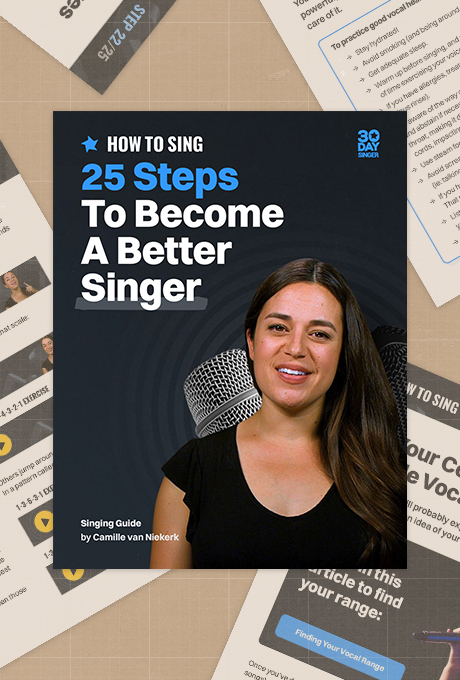Vocal Exercises
May 3, 2022
“Vocal Exercises”
Camille van Niekerk
Learn some of the most popular vocal exercises and melodic patterns used by singers and voice teachers today!
- Straw singing
Singing through a straw is a relatively new vocal exercise, but it’s become popular with singers, voice teachers and speech therapists for its many benefits.
Singing through a straw elongates the vocal tract (the space above your vocal folds, in which the sound wave vibrates), which allows you to achieve smoother transitions. It also provides back pressure to the vocal folds, helping them to balance your airflow with ease.
Try this for yourself by taking a drinking straw and submerging it in a cup of water, filled halfway. Sing an “oo” sound on any comfortable pitch through the straw. You want to make sound and bubbles at the same time. If that’s happening, you’re doing it correctly! If you just hear sound, that’s humming. And if you just see bubbles, that’s blowing air. You want both sound and bubbles to confirm that you’re actually singing through the straw.
Once you’ve got the hang of it, you can remove the straw and continue singing.
Pattern to try: slide from low to high and back down again, gradually widening the range.
- NG
The “ng” position can be found by saying the word “sing” and sustaining the ending “ng” sound. You should feel the back of your tongue touching your soft palate (the back of the roof of your mouth). Feel the difference between an “n” sound (made with the front of the tongue), and the “ng” sound (made with the back of the tongue).
The “ng” sound is especially helpful for balancing resonance, making it easier to transition from low to high without strain.
Pattern to try: 1-5-1 slide
Lower voices, sing: C3-G3-C3 (sliding up and down); C#3-G#3-C#3; D3-A3-D3; D#3-A#3-D#3; E3-B3-E3. Continue walking higher, using a piano app or virtual piano as a guide for your starting pitch!
Higher voices, sing: C4-G4-C4 (sliding up and down); C#4-G#4-C#4; D4-A4-D4; D#4-A#4-D#4; E4-B4-E4. Continue walking higher, using a piano app or virtual piano as a guide for your starting pitch!
- “Woo-woo!”
This is a great exercise for finding head voice function in an easy, relaxed way. Make a high-pitched, excited “woo-hoo!” sound, and that’s it! If “woo-hoo” feels easy, continue on that. Some students may prefer “woo-woo” instead, so feel free to try both.
The pattern is approximate: you’re making sound on the same pitch twice in a row and letting your voice “fall” or “slide” down from there, exactly as you’d naturally do when exclaiming “woohoo!”.
All voices: Start on A4 as your approximate pitch. This ensures that you’re finding your head voice function (especially for low voices, who may not be used to making sound in this range). Use a chromatic tuner (app or website) to confirm that you’re singing the correct pitch.
Lower voices: Gradually walk lower on the piano (G#4, G4, F#4, etc), then back up.
Higher voices: Gradually walk higher on the piano (A#4, B4, C5, etc), then back down.
- Arpeggio: 1-3-5-8-5-3-1
An arpeggio is a common melodic pattern within all of music, not just vocal exercises! When you sing (or play) the individual pitches of a chord in succession, that’s an arpeggio. For example, if you play C, E and G at the same time, you’re playing a C major chord. If you sing C, then E, then G, you’re singing a C major arpeggio.
Which syllable to sing on will depend on your vocal goals and development, so here are a few options:
a. Cuckoo clock: sing on a hollow “koo” sound to facilitate an easy transition into head voice
b. ONE: sing on the word “one” to build your mix (or middle) register
c. Bratty NAY: sing on the syllable “nay”, with a bratty, annoying, even nasal quality to build strength in the middle and upper register of your voice
Lower voices: Sing C3-E3-G3-C4-G3-E3-C3. Next, start on Db3 and sing the same melodic pattern (Db3-F3-Ab3-Db4-Ab3-F3-Db3). Continue walking up the piano, then back down.
Higher voices: Sing A3-C#4-E4-A4-E4-C#4-A3. Next, start on Bb3 and sing the same melodic pattern (Bb3-D4-F4-Bb4-F4-D4-Bb3).


